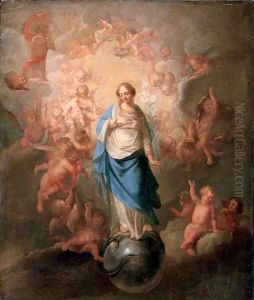Anton Raphael Mengs Bohemia Paintings
Anton Raphael Mengs was a prominent painter of the late Baroque and early Neoclassical periods. Born on March 12, 1728, in Aussig (now Ústí nad Labem, Czech Republic), in the region historically known as Bohemia, Mengs was the son of the court painter Ismael Mengs. His father, recognizing his son's talent early on, provided him with an intensive education in the arts.
From a young age, Mengs was exposed to the art of the masters, as he traveled with his father throughout Europe, including to Rome where he studied the works of Raphael and other Renaissance artists. His early exposure to such masterpieces had a profound impact on his artistic development. Mengs quickly became a successful portraitist and history painter, praised for his ability to blend the grandeur of the Italian tradition with the detailed realism of the Northern European style.
In 1741, Mengs moved to Rome, where he became deeply involved in the burgeoning Neoclassical movement, drawing inspiration from ancient Greek and Roman art. During his time in Rome, he became associated with important figures of the Enlightenment, including the art historian and archaeologist Johann Joachim Winckelmann, with whom he shared a close friendship and intellectual exchange.
Mengs's reputation grew, and he was appointed as court painter to Charles III of Spain. He spent several years in Madrid, where he painted portraits of the royal family and frescoes for the Royal Palace. His work in Spain was well received, and he continued to be a sought-after artist across Europe.
Among Mengs's most famous works are his frescoes in the Villa Albani in Rome, his portrait of the Infanta Maria Luisa of Spain, and his altarpiece 'The Adoration of the Shepherds' for the Church of the Three Kings in Dresden. His artistic style is characterized by its clarity, controlled composition, and the use of light to achieve a sense of volume and space.
Mengs continued to paint and write about art theory until his death on June 29, 1779, in Rome. He was an influential figure in the transition from Baroque to Neoclassicism, and his works and writings contributed significantly to the development of modern art criticism and theory. Mengs's legacy endures, and his works can be found in major museums and collections around the world.
